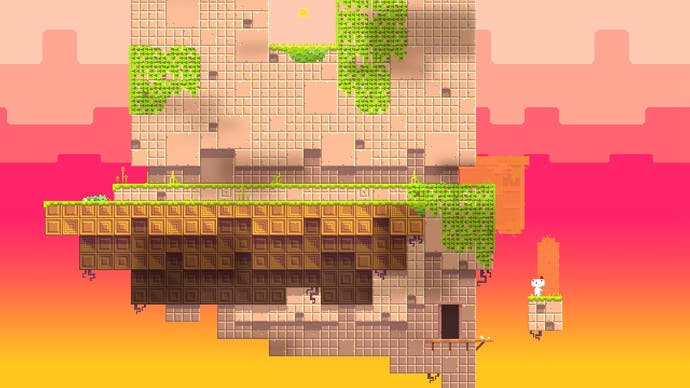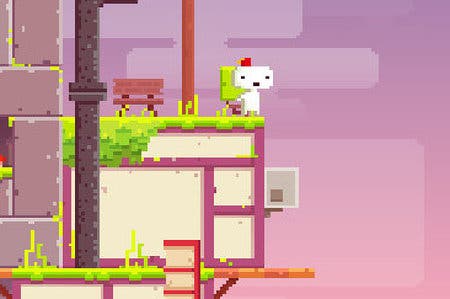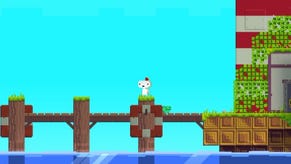Fez Review
Just like that.
You don't need to go hunting for meaning in Fez. Chat to the villagers at the very start of the game and one wise old coot says, "Reality is perception. Perception is subjective." If there's a theme to the perspective-shift puzzles of Polytron's "2D platformer in a 3D world," then there it is. Philosophy so dispensed with, we can all just get on with soaking up the mystery and wonder of this fabulous adventure game.
In Fez, you play Gomez, a blob-headed sprite living in a peaceful, two-dimensional pixel village. One morning, he witnesses a strange event in which a monolithic golden cube disintegrates into hundreds of fragments, threatening the fabric of his reality so much that it glitches, crashes and resets (with a nice impression of an old DOS boot screen). At the same time, a magical red hat - the fez of the title - grants Gomez knowledge of his world's greatest and oldest secret: there are actually three dimensions.
Now - as well as running, jumping and climbing as he seeks the cube fragments that made up the golden "hexahedron" - Gomez can rotate his world through 90 degrees before it snaps back into a flat plane. The perspective shift reveals hidden areas and realigns platforms; a yawning gap becomes an easy jump, a thin sliver becomes a wide gangway, and impassable distances are squashed into nothingness. It's a combination of the wraparound platforming of cult '80s game Nebulus with the Escher-like spatial non-sequiturs of Echochrome, and it's a wonderful conjuring trick.
It could have been the basis for a tough brain-teaser like Braid - but the first and most enduring of Fez's many wonderful surprises is how natural, intuitive and fun the perspective-shift is to play with. The game's exploration of the idea is unforced and playful throughout, and it never stops you at a mental roadblock.
Fez's creator, artist and designer Phil Fish, doesn't have the obsessive intellectual rigour of Braid's Jon Blow, or the same interest in messing with our minds. Nor is he particularly into other typical indie concerns such as allegory, reinvention, subversion or old-school reaction-test gaming. Fish clearly worships the Nintendo of his boyhood, and has dedicated himself to unearthing the sense of surprise and secret wonder you felt playing a Metroid, Zelda or Super Mario for the first time. And he's got closer than you ever thought possible.
The simple joy of exploration is at the very heart of the appeal of video games. In Fez, it's absolutely unfettered.
It's as if Shigeru Miyamoto had made his 2001: A Space Odyssey: a peaceable game of exploration, collection and riddling shot through with a trippy, 1970s flavour of surrealism. You'll unlock doors to forgotten cities. You'll discover warp routes and hidden worlds, and reach for a pad and pen to unscramble one of several secret languages scrawled on the walls (one is composed entirely of Tetris shapes).
Most of all, you'll marvel at the twists and branches of an unravelling world map as you go deeper, higher, further still - losing yourself down one of Fez's dozens of rabbit holes that always last a few steps longer than you expected, or take you somewhere you didn't think you'd be. A floating bell tower, perhaps, or a treetop observatory, or a seedy, abandoned tenement outlined against a sky that flickers like a neon sign.

The simple joy of exploration is at the very heart of the appeal of video games. In Fez - which features no combat or enemies, and only the mildest kind of platforming peril - it's absolutely unfettered.
A great deal of this is down to Fish's art, which is as evocative as it is painstakingly crafted. Every chunk of stone is weathered slightly differently to the next, every pixel (actually rendered as a full cube in 3D) placed by hand. But credit's also due to programmer Renaud Bédard, who has tackled what must be one of the most unusual technical challenges of this gaming generation, and composer Rich Vreeland (AKA Disasterpeace) whose otherworldly synth score is lush, spooky and electrifying.
Structurally, Fez is simple and traditional. You need to collect cubes and cube fragments to unlock new areas. 32 cubes get you to the exit and the game's boggling psychedelic wig-out of a climax; this will take you maybe half a dozen hours.
After that, you get the option to start a New Game + with all your cubes and collectables, and it will take at least as long again to gather 32 more cubes and fully complete the game. Many of these will be "anti-cubes", which are the reward for solving the tougher challenges, puzzles and frequently fourth-wall-breaking riddles. (New Game + also grants a hilarious and astonishing extra that lets you peek behind the curtain and see Fez in a whole new light.)
Like last year's Super Mario 3D Land, Fez arguably gets even better after it ends. Because the structure is very loose - the stages unlocked in the first half are curious offshoots rather than branches of the main tree - your route through the game will be organic and impulse-driven, and you'll be left with plenty still to explore in the second half.
It's during this stage that you'll seriously tackle the game's many secrets - all handily marked, but not at all spoiled, on the head-spinning 3D map screen. Think Miyamoto, Kojima or Schafer at their most impish: treasure maps, invisible platforms, secret messages delivered in unexpected ways, puns and tricks of the light.
There's a deeper mystery behind them all, too. In the hieroglyphic scrawls on the walls and the strange locations you find, you can piece together a little of the fragmented - but surprisingly coherent - story of an ancient civilization, and how the inhabitants of this weird half-flat world struggled to come to terms with its impossible depth.
It's a shame that, in the more than five years it has taken Fish and Bédard to perfect this remarkable game, the puzzle-platformer with retro pixel art has become a careworn cliché of the indie game scene. Although Fez is the darling of a certain indie clique and possesses its fair share of studied hipster cool, it's anything but a bandwagon-jump.
The game's unique artwork, its perspective-shift mechanic, its nostalgia for the 16-bit years and its bewitchingly strange setting all exist in total harmony and make a single, deliberate statement. Maybe it's about perception, reality and subjectivity, like the old man said. But I think it's about something else: what games were to us in their charged infancy, what they've expanded into in the 30 years since, and how to fold those things together into a single, beautiful whole.









